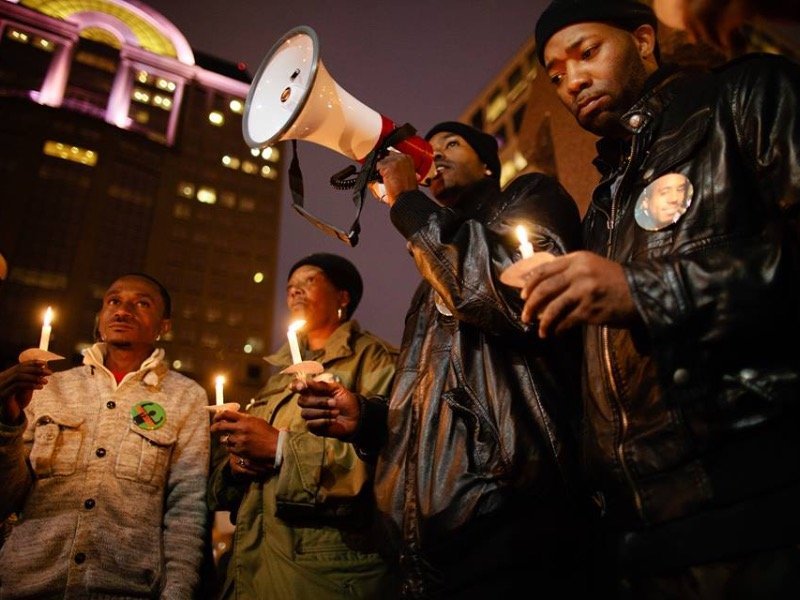The title of local filmmaker Erik Ljung’s powerful debut feature doc arrives close to the third act of the movie. Protesters – led by Nate Hamilton, whose younger brother Dontre was shot 14 times and killed by MPD officer Christopher Manney in spring of 2014 – march to Milwaukee County DA John Chisholm’s heavily police-protected home to sing "Silent Night" before lifelessly sinking and slumping to the pavement like dead bodies. "The blood is at the doorstep," hauntingly echoes Hamilton in the disturbed evening quiet.
Hamilton might be preaching specifically to Chisholm’s front door, but he might as well be calling out to the entire city of Milwaukee – especially those blank-eyed faces seen occasionally haunting the borders of Ljung’s film, perplexed and perturbed their everyday commute or pre-concert beer has been interrupted by a family mourning their murdered son.
The ghosts are knocking. The conversation’s arrived – and after three years of countless headlines, confused facts and deafening outcry from all sides, it receives an essential outlet in "The Blood is at the Doorstep," shining a light into one of the city’s darkest chapters and attempting to find something resembling clarity amongst the murk.
The actual Red Arrow Park incident itself is mostly restricted to the doc’s first act, and though short, it’s a necessary, clear-eyed reclamation of the case’s facts – even for those who felt they followed the case closely. Contrary to the early police statements and media reports, Dontre was neither homeless nor a young man with a police record; his house keys were in fact on his person at the time of his altercation, while his brother Nate was the one with the past armed robbery charge (a later press conference with Mayor Barrett and the family is an unfortunately empty second-place finish to the immediate inaccuracies).
Officers on two previous check-ins had also already chided not Dontre, but the Starbucks employees who called in his lawful presence with no reasoning. That didn’t stop the coffee shop, however, from making a third and tragically fatal call. Even with all the news stories over the years, it’s vital assembly and organization of the evidence and where the story stands now.
"The Blood is at the Doorstep" finds its true heart, however, in the event’s aftershocks, following the Hamilton family in the painful and prolonged aftermath of the shooting, coping with the heartbreak while also hunting for answers and accountability however they can find them.
Nate in particular winds up as the film’s lead character, quietly growing from a passive participant in the outcry – unfamiliar with a megaphone and at one point admitting one of his first immediate reactions was retaliation and angry violence before thinking better – to one of its loudest and clearest voices. It’s a subtly emotional and powerful arc for an exhausting story that tragically has no real end in sight.
The film, however, doesn’t settle for deification or simplification. Thanks to Ljung’s impressive access and hundreds of hours of footage – impressively honed done by editor Michael Vollmann into a concise, complex and mostly focused story – "The Blood is at the Doorstep" finds itself in the midst of several difficult decisions inside the Coalition for Justice protest group, with different leaders hotly trying to push and pull its direction.
One particularly raucous rally toward the Bradley Center ends with both Nate and Dontre’s mother, Maria Hamilton, arguing not with police or law enforcement, but with one of their own, about how best to pay tribute to Dontre yet still force change forward. The fight continues into their choice to block a freeway for one protest, with arrests at the event and group members afterward having to be separated, shouting across a room.
Like Ava DuVernay’s "Selma," Ljung captures the tough but honest tension of trying to unify a mass of people and anger under one way – with no assurance it’s the most effective one.
That approach even extends to the Milwaukee Police Department too, as Chief Flynn and DA Chisholm both speak with the film about the case’s tricky nuances. While the movie pointedly notes the mandated outside investigators – a new law one subject says the city was likely unprepared for – had strong ties to MPD, Flynn notes that there are few others qualified for a homicide case in the mostly rural state.
Even Manney is allowed his say and defense, with officers coming to his aid albeit contrasted with his past record of violent on-the-job altercations (including a fight with a literal clown – yes, there is video).
The result is an even-handed look at a case that’s inspired few even-headed reactions, all while still keeping its fingers firmly on the human pulse of the people involved. Unlike the deservedly bleak outlooks of similar police/community documentaries, there’s room for humor – one Hamilton family member has a priceless reaction to an upcoming tea party – and hope.
The opening, set in the uproar after Sylville Smith’s shooting years later, sets up "The Blood is at the Doorstep" for a grim and despairing conclusion. Instead, the final frames land less on the damage and more on the repair – as well as the strength of Nate, Maria and others to soldier forward through their sorrow for the sake of change and community.
As a Milwaukeean, "The Blood is at the Doorstep" is vital viewing, a crucial document to understanding an ugly but essential thread in the city’s fabric. It may not settle any debates – and its sprawl may have you wish it focused in more in a few areas – but it’s the most thorough telling yet. And as a film fan, the doc serves as a powerful story of persistence and the challenge of change – a story that sadly sees no end in sight. The protest in front of Chisholm’s house may have left, and Dontre's case may have closed in the law's eyes. But the blood is still at Milwaukee’s doorstep.
"The Blood is at the Doorstep": ***1/2 out of ****
As much as it is a gigantic cliché to say that one has always had a passion for film, Matt Mueller has always had a passion for film. Whether it was bringing in the latest movie reviews for his first grade show-and-tell or writing film reviews for the St. Norbert College Times as a high school student, Matt is way too obsessed with movies for his own good.
When he's not writing about the latest blockbuster or talking much too glowingly about "Piranha 3D," Matt can probably be found watching literally any sport (minus cricket) or working at - get this - a local movie theater. Or watching a movie. Yeah, he's probably watching a movie.







